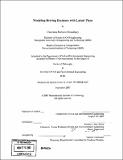| dc.contributor.advisor | Moshe E. Ben-Akiva. | en_US |
| dc.contributor.author | Choudhury, Charisma Farheen, 1978- | en_US |
| dc.contributor.other | Massachusetts Institute of Technology. Dept. of Civil and Environmental Engineering. | en_US |
| dc.date.accessioned | 2008-09-03T14:55:53Z | |
| dc.date.available | 2008-09-03T14:55:53Z | |
| dc.date.copyright | 2007 | en_US |
| dc.date.issued | 2007 | en_US |
| dc.identifier.uri | http://hdl.handle.net/1721.1/42220 | |
| dc.description | Thesis (Ph. D.)--Massachusetts Institute of Technology, Dept. of Civil and Environmental Engineering, 2007. | en_US |
| dc.description | Includes bibliographical references (p. 227-238). | en_US |
| dc.description.abstract | Driving is a complex task that includes a series of interdependent decisions. In many situations, these decisions are based on a specific plan. The plan is however unobserved or latent and only the manifestations of the plan through actions are observed. Examples include selection of a target lane before execution of the lane change, choice of a merging tactic before execution of the merge. Change in circumstances (e.g. reaction of the neighboring drivers, delay in execution) can lead to updates to the initially chosen plan. These latent plans are ignored in the state-of-the-art driving behavior models. Use of these myopic models in the traffic simulators often lead to unrealistic traffic flow characteristics and incorrect representation of congestion. A modeling methodology has been formulated to address the effects of unobserved plans in the decisions of the drivers and hence overcome the deficiency of the existing driving behavior models and simulation tools. The actions of the driver are conditional on the current plan. The current plan can depend on previous plans and be influenced by anticipated future conditions. A Hidden Markov Model is used to address the effect of previous plans in the choice of the current plan and to capture the state-dependence among decisions. Effects of anticipated future circumstances in the current plan are captured through predicted conditions based on current information. The heterogeneity in decision making and planning capabilities of drivers are explicitly addressed. The methodology has been applied in developing driving behavior models for four traffic scenarios: freeway lane changing, freeway merging, urban intersection lane choice and urban arterial lane changing. In all applications, the models are estimated with disaggregate trajectory data using the maximum likelihood technique. | en_US |
| dc.description.abstract | (cont.) Estimation results show that the latent plan models have a significantly better goodness-of-fit compared to the 'reduced form' models where the latent plans are ignored and only the choice of actions are modeled. The justifications for using the latent plan modeling approach are further strengthened by validation case studies within the microscopic traffic simulator MITSIMLab where the simulation capabilities of the latent plan models are compared against the reduced form models. In all cases, the latent plan models better replicate the observed traffic conditions. | en_US |
| dc.description.statementofresponsibility | by Charisma Farheen Choudhury. | en_US |
| dc.format.extent | 238 p. | en_US |
| dc.language.iso | eng | en_US |
| dc.publisher | Massachusetts Institute of Technology | en_US |
| dc.rights | M.I.T. theses are protected by
copyright. They may be viewed from this source for any purpose, but
reproduction or distribution in any format is prohibited without written
permission. See provided URL for inquiries about permission. | en_US |
| dc.rights.uri | http://dspace.mit.edu/handle/1721.1/7582 | en_US |
| dc.subject | Civil and Environmental Engineering. | en_US |
| dc.title | Modeling driving decisions with latent plans | en_US |
| dc.type | Thesis | en_US |
| dc.description.degree | Ph.D. | en_US |
| dc.contributor.department | Massachusetts Institute of Technology. Department of Civil and Environmental Engineering | |
| dc.identifier.oclc | 230939274 | en_US |
